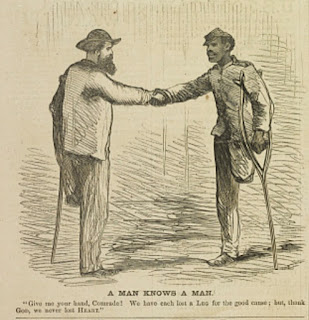 |
| James Broomell - Porter Cemetery - PCA Files |
On the 1840 Census, James Broomell was listed as 12 years old along with his grandmother Lydia Broomell, father John Broomell, and mother Sarah Broomell, along with the following siblings: George, Latitia, Elizabeth, Seneca, and Samuel.
At some point in 1860, he became a school teacher, and then later became soldier. The 124th Regiment of the Pennsylvania Volunteer Infantry was organized to meet the threat of the Confederate invasion of Maryland in August 1862. The length of service for the volunteers was to be 9 months. James Henry Broomell enlisted on August 6, 1862, at Oxford, PA. He was assigned the rank of Corporal in Company C and was mustered in on August 11, 1862.
Corp. Broomell’s Regiment was ordered to Washington D.C. on August 12 and they went into camp at Fort Albany, two miles south-east of the Capital. The 124th was next ordered to Rockville, MD, on September 7. It was ordered to march to meet the enemy the afternoon of the 9th. Then, on September 17, it was in the thick of the fight in the infamous Miller’s corn field during the Battle of Antietam. This battle was the “bloodiest” day of fighting in the entire Civil War; in fact the “bloodiest” day in United States history. The 124th lost 50 men in killed and wounded that day. Total casualties were some 23,000 soldiers.
By December 10, the 124th Pennsylvania was camped in the neighborhood of Harper’s Ferry. It was ordered forward by a forced march in bad weather to participate in the looming battle at Fredericksburg, VA. By the time it arrived, the fighting was over.
The next major assignment of Corp. Broomell’s Regiment was the Chancellorsville campaign. It formed a line of battle on the afternoon of April 30, 1863. The fight with the Confederate army began the next morning. The Union troops were gradually forced into a strictly defensive situation and all hostile action ceased by May 6. The 9-month term of service for this Regiment ended on May 9 and it was returned to Harrisburg, PA, where Broomell was mustered out on May 17.
One month later, the governor of Pennsylvania was informed that Confederate General Robert E. Lee was again intent on invading the North. Governor Curtin issued a proclamation on June
12 asking for men to volunteer into “emergency” militia regiments. President Lincoln also called for 100,000 men from Pennsylvania, Ohio, Maryland, and West Virginia to serve for 6 months or as long as necessary during the emergency. Broomell again answered the call to serve and enrolled June 15, 1863, at Oxford, PA. He was mustered in on June 19 at Harrisburg as a Private in Company A of the 29th Pennsylvania Militia Infantry and immediately promoted to Sergeant.
This regiment was organized by June 23 and immediately put to work building fortifications around Harrisburg. It experienced some combat when a mounted Confederate force raided some nearby Pennsylvania towns and threatened Harrisburg. Private Broomell’s regiment did not engage in fighting in the Gettysburg area. The main purpose of these “emergency” militia regiments was to guard railroads, bridges and fords over major rivers and to protect Federal property in Pennsylvania. Private Broomell was mustered out of service on August 1, 1863, at Harrisburg, PA. His soldiering days were over.
For more information on the life of James Broomell, and to see him in Porter Cemetery, come to the Pioneer Military and Memorial Park when it opens! - adapted from a story by Jan Huber










